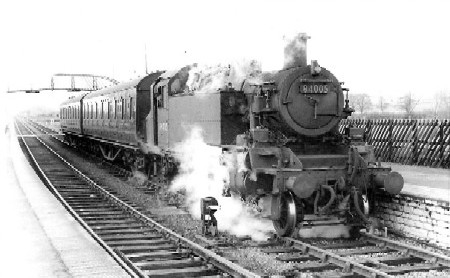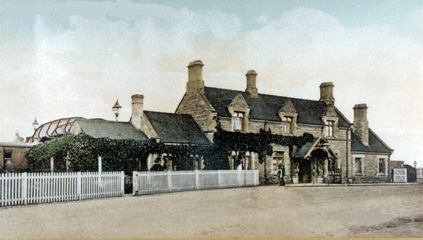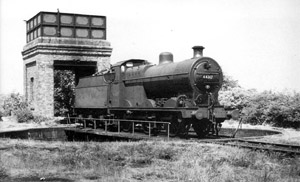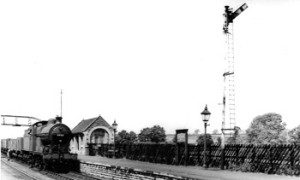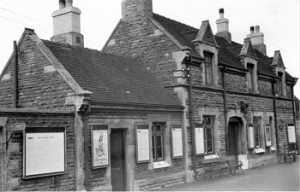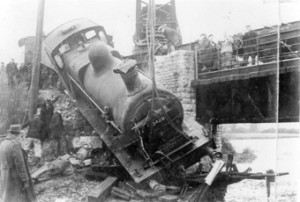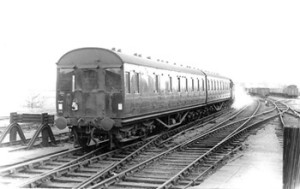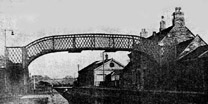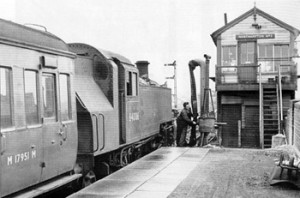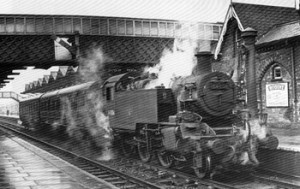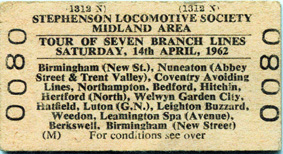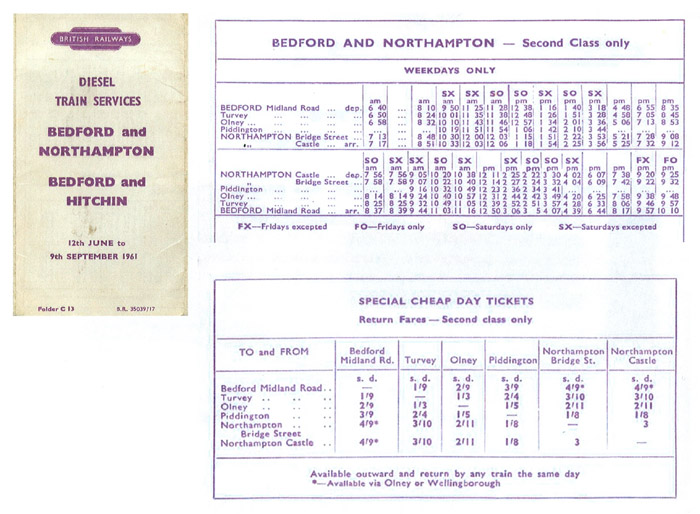Why not start with the video of Olney’s railway which includes some additional photographs?
A View From Olney
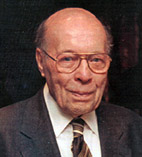
Ivor Neale
This article was written by Ivor Neale in 2004 when he was approaching his 90th year and relates his memories as he recalled them. Ivor died in April 2010.
My first experience of the Northampton – Olney – Bedford railway was in March 1930 when our family came to live in Olney. On our journey from Cornwall it was necessary to change stations at London and then trains at Bedford for Olney. This twin track branch line linked the LMS main line out of Euston to Birmingham, Manchester and Scotland, with the LMS main line out of St Pancras going to Nottingham, Derby, and Sheffield.
Passenger trains ran at about two-hourly intervals from Olney to Northampton and from Olney to Bedford on weekdays and Saturdays. There never was a Sunday service. This frequency of passenger services was maintained from the 1930’s until the line was closed in 1962. In the 1930’s, people used the trains as they were cheap, comfortable and ran at convenient times, particularly for Northampton.
Most men worked on Saturday mornings so many Olney people would travel by train in the afternoon to go shopping, or to see Northampton Saints or Cobblers play. People also travelled by train to visit the cinemas or the theatres. On Saturday evenings a train left Olney for Northampton at 5.15 pm and arrived back at 9.45 pm. In those days the fare was about 1/6d (7½ p).
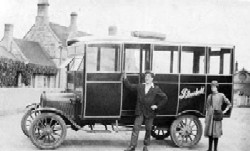
‘Bob’ Wesley’s early transport to Olney Station
The passenger trains from Olney terminated in Northampton at St John’s Street station which was at the bottom of Guild Hall Road. This station was very handy for the town centre but when it was closed, in the late thirties, the trains then stopped first at Bridge Street station before going on to Castle station, which was not so convenient for passengers.
Olney station was very attractive. The main building was constructed of stone and had a large entrance porch. It also had a large forecourt, presumably to allow, in earlier times, the horse-drawn carriages to manoeuvre. Like most small stations, the station master at Olney lived in rooms at one end of the building, which made a suitable home for a small family. In the 1930’s the Station-master was Mr Slater. A door connected his rooms with the booking office. A clerk sold tickets through a very small ‘pigeon hole’ window into the booking hall. Pre-printed tickets were kept in a large rack under the names of the stations that passengers were most likely to request.
The station was lit by gas, with chains to switch the lights on and off. In the winter the waiting room often had a good coal fire going as there was never a shortage of coal around the station. All manner of small goods, such as day-old chicks in boxes and racing pigeons in baskets, were kept in the waiting room. The telegraph bell ‘rang in’ about five minutes before the passenger train arrived, so people knew if the train was on time.
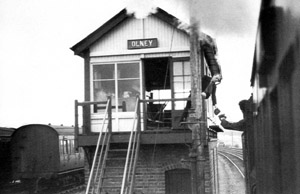
Olney signal box (issuing the ‘token’, allowing the train to use the single track) Picture courtesy of Mr K Fairey
The signal-box was located about half way between the station and the river, where several sidings linked up to the goods yard. At one time, the signal-box was manned twenty four hours a day, and so employed a number of men working shifts. In the 1950’s, school visits were made to the station and signal-box showing the children how the railway worked. Around this time the station master was Frank Robinson with Lois Sargent in the Booking Office. Hubert (Ding-Dong) Clark and (later) Cliff Grimes manned the station; Bert Fraser and George Taylor were two of the staff manning the signal-box.
A turntable that could accommodate the large engines that pulled the goods trains was sited near to the signal box. It was operated by one man turning a handle to reverse the direction of the engine. A large tank on top of a brick tower stood near the turntable and supplied water for the engines. A number of allotments were provided for railway workers on the south side of the signal-box.
In the 1930’s a gang of about six local men were involved in keeping the track around Olney in safe working order. Messrs Freeman, Partridge, Ingram and Pearson were some of those employed on track maintenance. A man had to walk the track to check that all the ‘keys’ were holding the rails in the ‘chairs’. There was a ‘chair’ on each side of the sleeper for each rail to rest on, then the ‘key’ (an oak block about seven inches long, slightly tapered and shaped to fit the rail) would be hammered in to keep the rail in position. During hot weather, the rail expanded and when it cooled, some of the keys could become slack and would have to be tapped back into the ‘chairs’. Although this did not happen too often, it meant that a daily watch had to be kept on the track.
At that time the area around Olney station was very busy. The goods yard was lined with lorries, horse-drawn drays and carts, parked alongside the rows of open wagons and covered vans waiting to be loaded or unloaded. The yard foreman had to plan the shunting of the trucks so that the traders could fill or empty them with the minimum of interference from nearby vehicles.
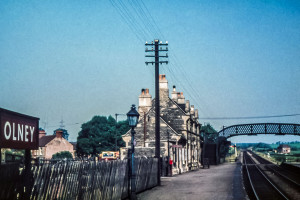
The Platform for Northampton. Picture taken in 1961 by William Alfred Carden and displayed courtesy of his grandson Dik Whibley
Hundreds of tons of coal were processed through the yard during the winter months. The suppliers included C T Wilson, Ellis and Everard and Harry Lett. Men moved all the coal with shovels. They stacked it in large heaps or put it into sacks, each weighing one hundredweight (112 lbs or approximately 50 kg). If the trucks were not emptied in the allotted time the suppliers would have to pay the railway an excess charge for each extra day.
Animal foodstuffs, grain and farm equipment for the area went through the station goods yard. Sheep and cattle were put into pens in the station yard before being loaded into cattle trucks; some of the animals were in a very distressed state. Horses were also sent by rail in special wagons. These had a compartment at one end for a groom so he could keep his eye on the horses.
When the sawmill at Yardley Hastings started up (where my Dad was in charge in the early 1930s), several lorry loads of sawn timber were dispatched to Olney station each week, en route for the railway workshops. A particularly unpleasant commodity sent at regular intervals to the station goods yard was a very smelly greenish sludge from the Tanyard. It was taken down the High Street in an open cart; not very environmentally friendly!
A horse-drawn dray, driven by Mr Bransome in the 1930’s, delivered the small articles and parcels around Olney. A large quantity of parcels was transported by rail in those days. Barrick’s the newsagents collected the newspapers off the first train at 7.00 am every morning. All GPO letters and parcels went from Olney by train to Bedford at various times of the day. The last collection in the 1930’s was at 9.10 pm from the letterbox in the wall near Brock’s Garage.
Olney being in a valley, on some nights a heavy loaded goods train on the incline towards Northampton would ‘chuff-chuff’ to a standstill through lack of steam. It was impossible for the train to restart from that position so it would have run back into Olney station. To get up a good head of steam the poor fireman would need to shovel coal into the firebox for all he was worth! I am told that the trains would have to back up the line towards Turvey to gain enough speed through the station to get them up the incline.
I remember during one night in 1930 or 1931, a goods train going up the same incline suffered a broken coupling, resulting in a number of trucks running back towards the station. Gaining speed as they went, they eventually crashed down the embankment from the station yard into a field near the river, quite a pile up! In those days each train had a guard’s van but I don’t remember what happened to the guard. In another accident in the 1950’s, an engine finished up down the embankment close to the river. Olney station was obviously not without the odd incident.
Moving up the line about three miles towards Northampton, a single-track railway line branched off to Towcester at Ravenstone Junction. This line was the last section of the Stratford-upon-Avon, Towcester & Midland Junction Railway and opened in 1891. Although its regular passenger traffic operations were short lived, the railway did provide a cross-country link for goods traffic. The only passenger train to use this line in the 1930’s and 40’s was an excursion train that ran on Easter Monday from Luton to Towcester Races. The fare from Olney in the 1930’s was 1/6d return (7½ p). In 1932 I went on this excursion train, just out of curiosity. It was a pleasant journey through the countryside at about 20 mph, arriving at Towcester in good time for the races. The station at Towcester was a good walk from the racecourse, perhaps a mile. The good weather made this outing very enjoyable.
Piddington Station, about half way between Olney and Northampton, could never be mistaken for Paddington! It was a small station in the middle of nowhere, miles from the village that bore its name and was probably nearer to Horton or Denton. The station was always kept very clean and tidy with colourful flowerbeds in the spring and summer. Very seldom was there more than one passenger seen to get on or off. There was a branch line from Piddington Station to a Ministry of Defence armament storage depot in Yardley Chase; in use until the 1970’s.
Trains also ran on branch lines from Northampton to Blisworth and from Northampton to Wellingborough. My parents on their return from their first visit to Northampton in the early 1930’s boarded the train waiting in the station and were surprised when it started a few minutes early. They soon realised that they were on the train to Wellingborough and would need a taxi to get them home. The taxi fare from Wellingborough to Olney late in the evening was very expensive in those days.
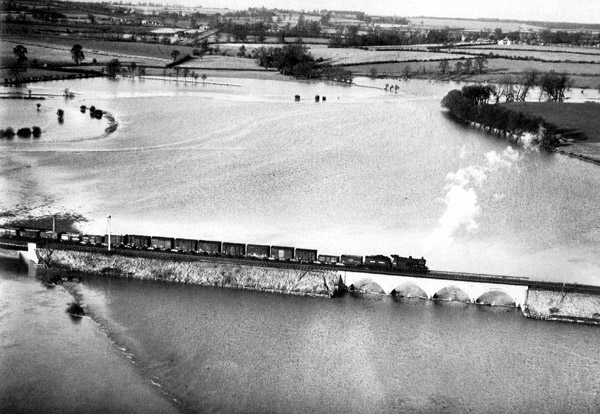
Train crossing the River Ouse bridge and viaduct during floods in February 1951.
Photograph courtesy of Simmons Aerofilms
Travelling by train from Olney to Bedford, passengers were expected to cross the line to the other platform using the footbridge. Most ‘locals’ took the quicker and more dangerous route crossing the line at the north end of the platform used by parcel trolleys. The design of the footbridge was unusual, only a few were built with such an attractive lattice pattern.
Beyond the south end of the station sidings, the trains first crossed a beautiful iron bridge over the River Ouse and then a limestone viaduct over the flood plain, before the start of the incline towards Clifton Reynes. These bridges were used by Olney people as an unofficial footpath to Clifton Reynes, even though they were under threat of prosecution by the Railways Board (so the notice said!). This route was a very convenient short cut and indeed was very popular on Sunday evenings in the summer Family walks on Sunday afternoons and evenings were popular in those days.
The train ran close to Newton Blossomville; I often thought there should have been a ‘Halt’ there. On the road between Clifton and Newton the remains of the bridge that went over the track can still be seen. Further on towards Bedford is Turvey station. Much like Piddington station, Turvey station was quite a distance from Turvey village and few passengers ever used it. At least there was the Railway Swan Inn close by! Later, a number of bungalows for pensioners were built near the station, and then alas, the railway was closed.
From about 1930 to 1950 during the winter the twin track line between Olney and Turvey was reduced months to a single track. The other track was used to park between 100 – 200 passenger coaches which would undergo minor repairs and be painted up for the summer holiday traffic. This work kept several ‘Wolverton Works’ men employed when the weather was not too bad.
Leaving Turvey, the railway line ran towards Stevington and Oakley passing close to a working windmill (a post mill design). It was a picturesque sight and I believe it has been renovated. Proceeding further towards Bedford the line joined the Midland main line at Oakley Junction for the final two or three miles fast run into Bedford Midland station. The fare to Bedford in the 1930’s was 1/5d return (about 7p).
The passenger trains continued to operate throughout the 1940’s and 1950’s, but with motoring becoming more affordable, their use declined considerably. The passenger services and fares for 1961 are shown in the tables (sorry, could not produce tables for the 1930s, 40’s or 50’s!). The journey from Olney to Northampton took 19 minutes and cost 2/11d return, about 14½ p, pretty good value even in 1961.
During the 1940’s and 50’s, the residents in Cowper Street always knew if engine driver Eric Freeman was on the footplate, as he gave a short blast on the whistle to his parents, who lived in the street for many years.
It was more than a little sad to see the steam engines replaced by diesel, but at least it looked as if events were going in the right direction. However, Dr Beeching came on the scene. He was famous for being paid a fabulous salary at that time, £24,000 a year, to put British Rail on a profitable footing. The Northampton to Bedford branch line was planned for closure and Olney suffered accordingly. The last regular passenger train passed through Olney in March 1962.
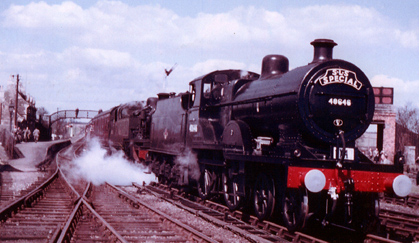
The Stevenson Locomotive Society Special at Olney – 14th April 1962
Photograph courtesy of Alan Richardson
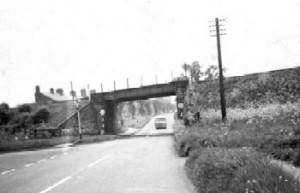
Bridge over Wellingborough Road
(Now the site of the A509 roundabout leading to Lavendon and the Driftway)
Soon after, one track was taken up and the other carried a few goods trains until about 1965, when the railway traffic through Olney was no more. Eventually the lines were taken up and the bridges removed.
It is interesting to read, in recent times, that efforts are being made by BRTA (Bedfordshire Railway & Transport Association) to revive the Northampton to Bedford railway. I sincerely wish them every success with this venture. In the 1930’s, on arriving back at the station, passengers were prepared to walk and carry their shopping to the other end of Olney. If the revival is successful one big difference will be the large car park necessary to service the local passengers and their shopping!
Acknowledgements
The Olney and District Historical Society are indebted to the following for allowing their photographs to be displayed on this site: Simmons Aerofilms, Ken Fairey, Richard Coleman, Alan Richardson and the Cowper & Newton Museum; also to WD Wharton, publishers, 37 Sheep Street, Wellingborough. Thanks also to the photographers/ owners we could not trace.
Further reading
Steaming into Northamptonshire – Richard Coleman & Joe Rajczonek (1988)
Steam Railways in Colour around Northamptonshire – Richard Coleman & Joe Rajczonek (1993)
.
Copyright © 2005 Olney & District Historical Society

